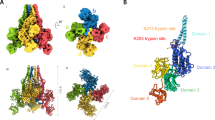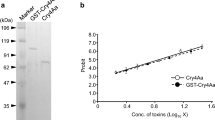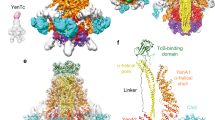Abstract.
After activation, Bacillus thuringiensis (Bt) insecticidal toxin forms pores in larval midgut epithelial cell membranes, leading to host death. Although the crystal structure of the soluble form of Cry1Aa has been determined, the conformation of the pores and the mechanism of toxin interaction with and insertion into membranes are still not clear. Here we show that Cry1Aa spontaneously inserts into lipid mono- and bilayer membranes of appropriate compositions. Fourier Transform InfraRed spectroscopy (FTIR) indicates that insertion is accompanied by conformational changes characterized mainly by an unfolding of the β-sheet domains. Moreover, Atomic Force Microscopy (AFM) imaging strongly suggests that the pores are composed of four subunits surrounding a 1.5 nm diameter central depression.
Similar content being viewed by others
Author information
Authors and Affiliations
Additional information
Received: 14 July 2000/Revised: 28 December 2000
Rights and permissions
About this article
Cite this article
Vié, V., Van Mau, N., Pomarède, P. et al. Lipid-induced Pore Formation of the Bacillus thuringiensis Cry1Aa Insecticidal Toxin. J. Membrane Biol. 180, 195–203 (2001). https://doi.org/10.1007/s002320010070
Published:
Issue Date:
DOI: https://doi.org/10.1007/s002320010070




